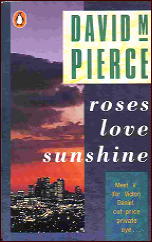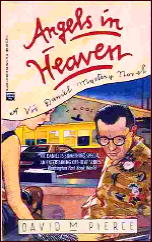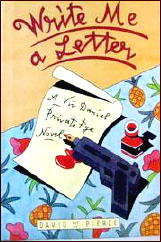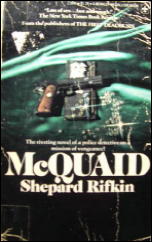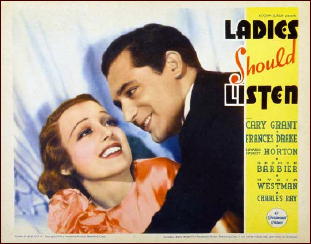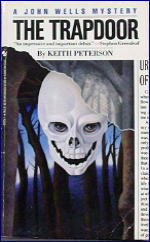September 2011
Monthly Archive
Mon 19 Sep 2011
IT’S ABOUT CRIME, by Marvin Lachman
ELIZABETH POWERS – All That Glitters: The Case of the Ice-Cold Diamond. Doubleday, hardcover, 1981. Avon, paperback, 1983.
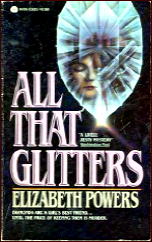
Years ago Mary Roberts Rinehart’s heroines wandered into trouble in mansions with secret passages. More modern is Viera Kolarova in Elizabeth Powers’ All That Glitters, who travels all over New York City, finding bodies, running from killers, and only as an afterthought informing the police of what she has learned.
She finds her first corpse just prior to the weekend, saying cleverly, “Thank God Friday only comes once a week.” That offset such Had-I-But-Known lines as “I might have reflected a bit on what was bothering me and have saved myself the trouble of the mess I got into.”
Incidentally, acting the role of what Boucher called “the Gothic idiot” is not restricted by sex. Many years ago, I observed the same characteristics in a male, Professor Foley in Michael Kenyon’s May You Die in Ireland (1965).
— Reprinted from The MYSTERY FANcier,
Vol. 12, No. 4, Fall 1990 (slightly revised).
Bibliographic Note: Viera Kolarova made one later appearance, in On Account of Murder, a paperback original from Avon in 1984. As a refugee from Communist Czechoslovakia who finds work in New York City, her name correctly spelled is Viera Kolářová.
Mon 19 Sep 2011
THE ARMCHAIR REVIEWER
Allen J. Hubin

DAVID M PIERCE – Down in the Valley. Penguin, paperback original, 1989.
David M Pierce, a Canadian with a colorful background (songwriter, co-author of a musical and a cookbook, Shakespearean actor, and poet, most of this in England), arrives on our scene with Down in the Valley. This offers us V. (for Victor) Daniel, 6′ 7-1/4″, ex-con, wearer of Hawaiian shirts loud enough to wake the dead, and private investigator in the San Fernando Valley of LaLaLand.
Here Daniel has a variety of cases in process, of which the most noticeable (and, apparently, most deadly) has to do with a local high school in which unlawful chemicals flourish.
Pierce has the PI patter down very nicely, keeps the plot well aboil, peoples it colorfully (to say the least), and entertained me exceedingly well. I could do with more of these, and in fact two more Daniel capers are in print, shortly to be sampled by me.
— Reprinted from The MYSTERY FANcier,
Vol. 12, No. 4, Fall 1990.
The Vic Daniel series —
Down in the Valley. Penguin 1989.
Hear the Wind Blow, Dear. Penguin 1990.
Roses Love Sunshine. Penguin 1990.
Angels in Heaven. Scribner, UK, 1991. Mysterious Press, US, 1992.
Write Me a Letter. Scribner, UK, 1992. Mysterious Press, 1993.
As She Rides By. St.Martin’s 1996.
Mon 19 Sep 2011
SHEPARD RIFKIN – McQuaid in August. Doubleday Crime Club, hardcover, 1979. No paperback edition.
Even though Damian McQuaid is a homicide detective, for the NYPD, this is definitely not your average sort of police procedural. It’s August, it’s hot, and McQuaid has only two days to solve a case on his own before someone discovers the body of the girl in whose apartment he spent the night.
Finding the killer is not enough. Without the usual power of the police department behind him to help gather the evidence he needs, McQuaid is forced to resort to an intricate cat-and-mouse game of active harrassment in order to produce a “voluntary” confession.
As a leading character, his excursions beyond the letter of the law evoke both admiration and a surprising lack of sympathy; part of the fascination reserved to the reader appears to be watching him stay, barely, on the side of sanity himself.
Rating: A Minus.
— Reprinted from The MYSTERY FANcier, Vol. 3, No. 6, Nov/Dec 1979 (very slightly revised). This review also appeared earlier in the Hartford Courant.
Bibliographic Data:
The Lt. Damian McQuaid series —
McQuaid. Putnam 1974.
The Snow Rattlers. Putnam, 1977.
McQuaid in August. Doubleday, 1979.
Not in the series is The Murderer Vine (Dodd, 1970), recently reprinted by Hard Case Crime (2008). It’s a work of fiction based on the murder of three civil rights workers in Mississippi (James Chaney, Andrew Goodman and Michael Schwerner) during the Freedom Summer voter registration drive.
Rifkin’s other crime novel is Ladyfingers, a paperback original published by Gold Medal in 1969.
Sat 17 Sep 2011
SEARCH AND DESTROY. 1979. Perry King, Don Stroud, Tisa Farrow, George Kennedy, Tony Sheer, Jong Soo Park. Director: William Fruet.
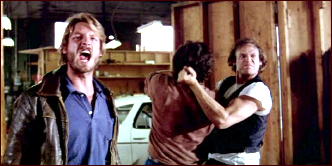
First Blood, the first Rambo movie, was made in 1982, and at the time, that was the earliest post-Vietnam War movie I remember seeing. Until this one, that is. I’m no expert on the genre, but since the war didn’t end until 1975, and no one was very much interested in seeing films about that particular military debacle, Search and Destroy may have been among the first.
And despite a story line that doesn’t allow much room for digression, it’s a good one. It takes place in 1978, with members of a small platoon of Vietmam vets in the process of being hunted down and killed. It seems that the group was ambushed during one of their missions, and in the confusion of the attack and the haste of the retreat they left an Vietnamese advisor behind. To die, so they assumed, but — you’ve caught on already? — no indeed, he did not.

Two of the still surviving vets (Perry King and Don Stroud) live in the Niagara Falls area, which makes a terrific background for the action film of retribution and revenge, both the falls themselves and the rather shabby town that’s been built up next to it. (I’m told most of the movie was filmed on the Canadian side, even though it’s meant to be the American, logically speaking.)
George Kennedy, in his usual fine pugnacious form, plays the police chief whose job is to stop the violence and keep the general populace safe. (Good luck on both!) Tisa Farrow, King’s slim girl friend looked awfully familiar to me, but the bell didn’t ring until after the movie was over, when I read through the credits again, and her last name finally jumped out at me. Jon Soo Park, who has the assassin’s role, didn’t have any lines to say, as I recall, but he’s quite effective as the methodical, single-minded killer, well-trained in the martial arts and other deadly skills.

But it’s only when the action moves to the background that the movie takes on any real purpose or meaning: about the buddies you make in wartime, the promises you make to each other, the highs that fighting a war without supervision can give you, and the lows that have to be overcome when you come home and try lead a normal life again.
If there were a little more of this side of the story, and a little less of firepower and other pyrotechnics, as grand as they may be, I wouldn’t hesitate in calling this a noir film – at least neo-noir. It didn’t have much of a budget, and I’m sure it was all but unknown when it was first released, but if you’re into this kind of film, this is a good one.
Sat 17 Sep 2011
Posted by Steve under
ReviewsNo Comments
IT IS PURELY MY OPINION
Reviews by L. J. Roberts
STEPHEN J. CANNELL – The Pallbearers. St. Martin’s, hardcover, March 2010; paperback, premium-sized, September 2010.
Genre: Police procedural. Leading character: Shane Scully; 9th in series. Setting: Los Angeles/Arizona.
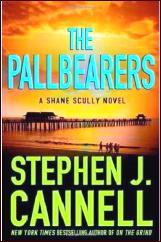
First Sentence: In 1976 America was just coming out of a protracted depression called the Vietnam War, but back then I was still in the middle of mine.
Homicide Detective Shane Scully was abandoned as an infant and grew up in the system. The only person who ever tried to give him some sense of being cared for was Walter “Pop†Dix, executive director of Huntington House.
When Shane is told Pop committed suicide and specifically asked that Shane be a pallbearer, it doesn’t make sense. Shane hadn’t seen Pop in years. When the other five pallbearers, all associated with Huntington House, convince Shane that Pop wouldn’t have committed suicide, and unofficial murder investigation, with a very unofficial team, begins.
As much as I’ve enjoyed Cannell’s television shows over the years, I’d never read one of his books. It seems I’d have been better staying with television.
On the positive side, Cannell does create an interesting cast of characters, providing background and dimension to each one, including the cat. He doesn’t assume you’ve
read previous books in the series, which I appreciated. He links the characters by a common thread but doesn’t quite tie off all the ends, which I didn’t mind.
I did appreciate not having Scully being infallible or supermacho, although there was macho there, such as being able to have sex after virtually no sleep for an extended period of time and having been beaten to a pulp. However, for the most part, his female characters are strong and very capable, which I also appreciated.
Cannell’s writing can be characterized by short chapters that are very visual and action-packed. On the downside, there are massive coincidences, an entire chapter of portents — those of you who’ve followed my reviews know how I despise portents — and some actions by the protagonist that were completely unbelievable. There points where the plot progression was so deliberately telegraphed it made it predictable.
I didn’t hate the book but even among airport books there are levels; those you deliberately take with you and those you’re stuck buying at the airport news shop of lack of choice. This is the latter but still an entertaining read to keep one occupied for a few hours.
Rating: Okay.
Fri 16 Sep 2011
Posted by Steve under
Reviews1 Comment
REVIEWED BY DAN STUMPF:
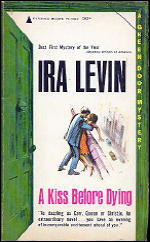
IRA LEVIN – A Kiss Before Dying. Simon & Schuster, hardcover, 1953. Edgar Award, Best First Mystery, 1954. Paperback reprints include, among others: Pyramid R-1067, Green Door Mystery, 1964; Pocket, May 1991 (both shown). Films: United Artists, 1956 (Robert Wagner, Joanne Woodward); Universal, 1991 (Matt Dillon, Sean Young).
I really try to organize my reading, but basically I’ve always been a slave to my own whimsy. So when I caught a passing reference somewhere to Ira Levin’s A Kiss Before Dying, I returned once again to those thrilling days of yesteryear (i.e., books I read in High School) and I’m glad I did.
Kiss is a classic of the form known as the Inverted Mystery: we know who-done-it and how, the fun is in seeing how they do it and whether they’ll get caught.
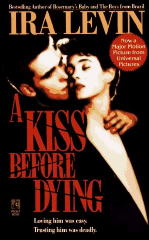
Levin’s anti-hero is a perfectly-sketched sociopath determined to marry a wealthy heiress, but when he gets her pregnant, rather than endure the stigma that will alienate her father — this is 1953, remember — he decides to kill her and free himself to pursue another, a path not completely free of some suspenseful complications deftly tossed in by a writer who knows how to toss them.
And things get even better in the second half when our hero finds himself the target of a plucky young heroine and a fan of Leslie Charteris. It’s touches like this, the odd bits of eccentric background thrown in, that really put Kiss across, and I’m glad I had a chance – forty years after I first read this — to visit it again.
Thu 15 Sep 2011
Posted by Steve under
Reviews1 Comment
THE BACKWARD REVIEWER
William F. Deeck
MAX MURRAY —
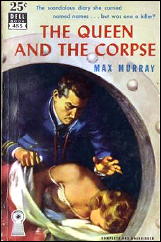
â— The Queen and the Corpse. Farrar Straus, US, hardcover, 1949; Dell #485, mapback edition, no date [1951]. M. Joseph, UK, hardcover, 1960, as No Duty on a Corpse.
â— The Right Honorable Corpse. Farrar Straus, US, hardcover, 1951; Unicorn Mystery Book Club, April, 1951. Collier Books, paperback, 1965. M. Joseph, UK, hardcover, 1952.
In The Queen and the Corpse, on board the luxury liner Queen Alexandra are a group of people with an interest in fellow passenger Leonara Blith, secretary to the late unlamented Felicity Emmabrau. It seems that Blith has with her Emmabrau’s scandalous diary, intended for a New York publisher. But she doesn’t have it long.
Principal among those preoccupied with Blith is Peter Almsford, horse breeder, steeplechase rider, and who knows what all. It is he who at first reluctantly detects and discovers the murderer, sorting out the many red herrings.
Murray does well here, providing humor and good characterization, despite the astounding coincidences. The ending, however, is a disappointment, as is Almsford’s and the villain’s belief that a wife can’t testify against her husband.
Give this one a try anyhow; maybe you’re not the nitpicking type.
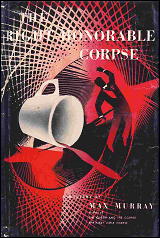
With a moderately interesting lead character, Martin Gilbert, pianist to the elite and spy for the Commonwealth of Australia, The Right Honorable Corpse has its moments. While Gilbert is playing the accompanying music, the Minister for Internal Resources, quite competent but generally loathed and feared, drinks some poisoned tea and expires.
Although Gilbert is supposed to work under his music cover, he begins giving people — at least the more intelligent ones — the impression that he is not just a handsome face and talented fingers and that underneath his cynicism and apparently blackmailing ways is a chap with the heart of a little boy.
If you like antiheroes or Australian settings, this novel may appeal. Otherwise, there’s not a great deal here.
An uneven writer, Murray, or maybe an uneven reader, Deeck. Murray’s The Voice of the Corpse I read with great appreciation. Good Luck to the Corpse and The Neat Little Corpse I couldn’t read at all. Although I finished The Doctor and the Corpse, it was a struggle.
— From The MYSTERY FANcier, Vol. 12, No. 4, Fall 1990.
Editorial Comment: Included in my own review of The Right Honourable Corpse, which I appear to have liked measurably better than did Bill, is a complete listing of Max Murray’s detective novels, plus some small pieces of information about him personally.
Thu 15 Sep 2011
REVIEWED BY WALTER ALBERT:
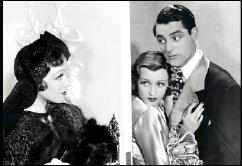
LADIES SHOULD LISTEN. Paramount, 1934. Cary Grant, Frances Drake, Edward Everett Horton, Nydia Westman, Rafael Corio, Rosita Moreno, George Barbier, Charles Ray. Frank Tuttle, director; screenplay by Claude Binyon and Frank Butler based on Guy Bolton’s play of the same name, as adapted from the French play La Demoiselle de Passy by Alfred Savoir. Director: Frank Tuttle. Shown at Cinevent 40, Columbus OH, May 2008.
The ’30s Paramount features are always eagerly awaited, since many of the them are still buried in the vaults of private collections, but in spite of the fine cast, this romantic comedy never really took off.
Grant, on the verge of major stardom, either had not yet found the style that would characterize his prime years or was uncomfortable with the material, and even dependable Edward Everett Horton was unable to pull this from its frequent doldrums.
Grant was pursued by Nydia Westman while hotel telephone operator Frances Drake, clearly destined to land Grant at the finale, wandered in and out of the meandering plot, attractive but with little comic spark.
Wed 14 Sep 2011
THE ARMCHAIR REVIEWER
Allen J. Hubin
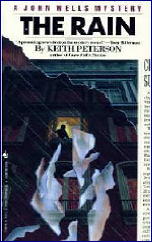
KEITH PETERSON – The Rain. Bantam, paperback original, December 1988. Softcover reprint by “Andrew Klavan writing as Keith Peterson,” Vista, UK, September 1997.
The third tale about New York reporter John Wells by Keith Peterson takes place exclusively in a sweltering August in New York City. A lowlife acquaintance of Wells’ invites him over and tries to sell him sexually compromising photos of an ostensibly strait-laced senatorial candidate.
Then the lowlife becomes a non-life, the photos disappear, and Wells’ paper is ignominiously scooped by the other rag in town. John’s popularity with his bosses reaches new lows, and a local mobster also takes a dim view of Wells’ meddling. It’s not clear he can work his way out of this mess even if he dies trying.
Beautifully plotted and paced.
— Reprinted from The MYSTERY FANcier,
Vol. 12, No. 4, Fall 1990.
Editorial Comments: I do not know whether the name behind the Keith Peterson pseudonym was known when Al wrote this review, but I suspect not, or it seems likely he would have mentioned it. The four “John Wells” books came out in a flurry, three in 1988 and one in 1989, then no more. I bought them all, and even though they looked interesting, I set them aside and almost totally forgot about them until now. Perhaps I shouldn’t have; see below:
The John Wells series, by Keith Peterson. —
There Fell a Shadow (n.) Bantam, August 1988.
The Trapdoor (n.) Bantam, 1988. [Nominated for the Edgar Award, Best Paperback Original.]
The Rain (n.) Bantam, December 1988. [Edgar Award for Best Paperback Original.]
Rough Justice (n.) Bantam October 1989.
Wed 14 Sep 2011
Posted by Steve under
ReviewsNo Comments
IT’S ABOUT CRIME, by Marvin Lachman
YVONNE MONTGOMERY – Scavengers. Arbor House, hardcover, 1987. Avon, paperback, August 1990.
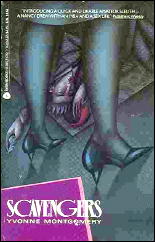
Many mystery writers grew up reading Carolyn Keene’s Nancy Drew and Mary Roberts Rinehart, and these roots are apparent in their writing. In Strangled Prose (1986), the first Claire Malloy mystery, Joan Hess often has her heroine compare herself to Drew.
Finny Aletter, in Yvonne Montgomery’s Scavengers calls herself “Nancy Drew, all grown up.” She is grown up, although still a bit unskilled at detection. She has become a successful Denver stock broker but is now ready to drop out of the business world because she prefers doing restoration carpentry work.
One of the reasons for her disenchantment is a sexist boss with “a new lease on lust,” and when he is found shot to death, Finny becomes a prime suspect. Ms. Montgomery has a nice knack of describing Denver and using clever lines, e.g., “as obsolete as a church key in a pull-tab world.” Dare we hope for a better puzzle in future books?
— Reprinted from The MYSTERY FANcier,
Vol. 12, No. 4, Fall 1990 (slightly revised).
Editorial Comments: Biblio-mystery fans, take note. Although I have not read it, also involved in Finny Aletter’s first appearance is a previously unknown Mark Twain manuscript. And in case you were wondering, her only follow-up case was Obstacle Course (Avon, paperback original, 1990).
« Previous Page — Next Page »


